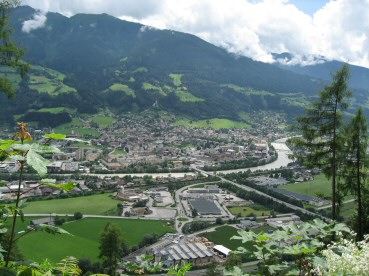As preparation and training for our great bicycle pilgrimage from Saint-Jean-Pied-de-Port to Santiago de Compostela, I (Gerhard) rode with my fellow pilgrim Hans from Innsbruck to Salzburg in April 2004.
We chose the Inntal cycle path to Rosenheim and then via Lake Chiemsee (Seebruck) to Waging and then along the Salzach, upstream to Maria Plain.

Stage start in Innsbruck at the Goldenes Dachl (Golden Roof).
Of course, we toured Innsbruck extensively by bike and rode through all the alleyways of the city centre. We visited Innsbruck Cathedral, which is dedicated to St. James. There you can see the original of Cranach's Mariahilf painting.
After a short drive we reach Hall in Tirol. The picturesque town with its late medieval character and many old town houses is worth a visit. Here I am standing at the entrance to the town. The old town is situated on a hill.
The Inntal Cycle Path continues via Wattens, past the "Crystal Worlds" via Schwaz and the exit of the Zillertal to Jenbach.

The Inntal cycle path passes Schwaz on the left bank. The city centre, however, is extremely worth seeing.
This photo is taken from the Way of St. James St. Georgenberg to Fiecht.
On the opposite bank of the Inn lies the
View of Schwaz with Freundsberg Castle from the Inntal cycle path. We visited the town.
In Franz Josef Strasse (pedestrian zone) in the direction of the parish church "Unserer lieben Frau". It is the largest Gothic hall church in Tyrol.
To zoom move the mouse over the image.

The Rottenburg castle ruins lie above Jenbach. A variant of the Jakobsweg leads over the castle ruins.
Rottenburg Castle was first mentioned in a document in 1263 and the lords of Rottenburg were among the most powerful nobles in the whole country. Later they were feudatories of the Counts of Tyrol, and the dynasty succeeded in amassing enormous wealth. In the 14th century, the Rottenburgs were the richest landlords in North and South Tyrol after the sovereigns.

The Notburga Chapel was built from the stones of the Rottenburg ruins.
Saint Notburga
at the pulpit foot in St. Stephen's Cathedral, Vienna (around 1500)
Saint Notburga was born in Rattenberg in 1265 and spent most of her life as a maid at Rottenburg Castle. She had a big heart for the poor and hungry and became known beyond Tyrol and Bavaria through the miracle of the shavings and the sickle and is still venerated as a popular saint today. In addition, she was the only one who managed to reconcile the hostile Rottenburg counts. This is commemorated by a reconciliation staircase in the ruins of Rottenburg Castle.
The miracle of the wood chipper
Text from a plaque at the Notburga Chapel near Rotholz (entrance to the Zillertal) below the Rottenburg.
It was here that the knight Heinrich II of Rottenburg once met his God-fearing maid Norburga, who was delivering money saved from her own mouth to the poor. Accusing her of
theft, he was blinded by God, saw wood shavings instead of food and tasted lye instead of wine. He thought he and his hard-hearted housewife Ottilie had been deceived and
expelled the saint from the castle. This happened in 1294, and since then happiness and peace had disappeared from Rottenburg until Henry II brought Notburga back.
The Sickle Miracle
Notburga entered the service of a farmer, promised to work extremely diligently and efficiently, but asked to be allowed to stop working on the eves of Sundays and feast days when the bells called for prayer. The farmer agreed, but did not keep his promise. For one evening when the holiday bells rang at the time of wheat cutting and Notburga wanted to go to church, he held her back. But she called on God to witness and judge between the farmer and her and hung her sickle in the air, where it remained - so the legend goes - until Notburga took it up again after the devotion.
The relics of St. Notburga are located at the main altar in the parish church Eben / Maurach

Before Brixlegg we discovered this sign on the Way of St. James (click on the picture to enlarge the sign) and visited the St. James niche at the little St. Gertraudi church and met Toni, the builder of the niche.
In the background you can see the ruins of Kropfsberg.
The Romans already maintained their road station Masciacum here. A castle was built on its site in the first half of the 12th century under Archbishop Konrad I of Salzburg. It served the Salzburg archbishops as a court and administrative seat, but also as an advanced border fortress against the Duchy of Bavaria and the County of Tyrol, and to secure their possessions in the Zillertal.
In the 16th century, Kropfsberg was one of the largest castles in Tyrol. The decline of Kropfsberg began in 1592 with the transfer of the Salzburg governor's seat to Zell am Ziller.

Toni, the builder of the Jacob's niche, and fellow pilgrim Hans in front of the Gertraudi church.
(I edited the photo on the PC, the niche is actually much higher up.)
Toni had great pleasure with us. Hans was allowed to play the organ in the Gertraudi Church and afterwards we were invited for a beer.
Fortunately, the stage finish was not far away.
The stage destination was Rattenberg, the smallest town in Austria. It was first mentioned in a document in 1254, and in 1393 it was elevated to the status of a town.
Rattenberg belonged to Bavaria until 1504. After that, Emperor Maximilian I was able to secure possession of the towns of Rattenberg, Kufstein and Kitzbühel by negotiation.
The tower of the castle ruins is in the background. The castle dates back to the 11th century and was expanded into an imposing fortress under Maximilian I.
We spent the night at the Schlosskeller inn.


